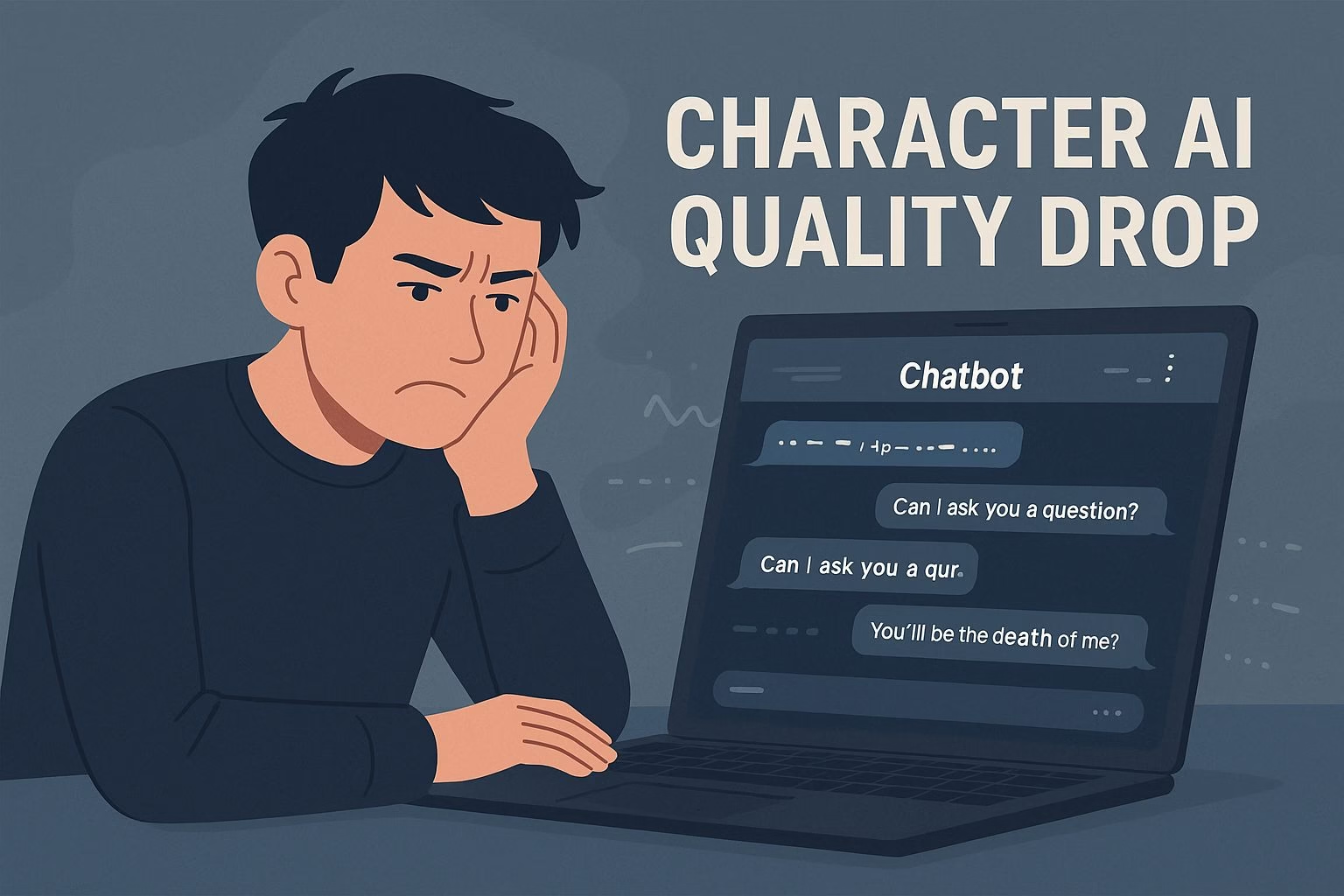Character AI Quality Decline After the Update
Summary
- Quality decline: Pipsqueak and Deepsqueak now produce shorter, repetitive, and less coherent messages after the latest update.
- User frustration: Both free and Plus users report memory loss, role confusion, poor grammar, and intrusive moderation filters.
- Possible causes: Server overload, stricter filters, or internal model changes affecting memory and context length.
- Future hopes: Users want transparency, longer replies, and model stability. Some have turned to alternatives for smoother experiences.
Many users have noticed a steep drop in Character AI’s chat quality since the latest update.
Both free and Plus users report that models like Pipsqueak and Deepsqueak no longer feel as immersive, expressive, or consistent as before.
Conversations that once flowed naturally now struggle with short, incoherent, or repetitive messages.
The problem seems widespread. Free users complain about bots “forgetting” context, using caveman-like language, or inserting random formatting quirks such as dashes and bold letters in odd places.
Paid users say that even their longer, premium responses have become frustratingly short. The most common thread is that quality peaked around August and began steadily declining after the Squeak models were added.
From an outside view, this seems to point to overloaded or reconfigured model servers. When memory fades, roleplay depth collapses, and responses turn bland, it usually means context handling or token limits have changed.
Some users think Bob’s overactive moderation system might also be interfering with responses, especially in adult chats where conversations abruptly stop or get filtered mid-scene.
If you’ve used the app recently, you’ve likely seen the same symptoms, cutoff messages, inconsistent tone, or bots acting out of character.
For many who relied on Character AI as a creative outlet, it now feels like a chore. The irony is that most say Pipsqueak and Deepsqueak were once their best models for writing improvement and immersive storytelling.
| Reported Issue | Possible Cause | Suggested Fix |
|---|---|---|
| Short replies and cut-off messages | Reduced output limit or server strain | Restore previous message length and optimize token management |
| Memory loss and confusion | Changes in memory context or persona data processing | Re-enable full character and memory field recognition |
| Overactive moderation filters (Bob) | Stricter 18+ content controls after policy update | Fine-tune detection to allow contextually safe scenes |
| Repetitive phrasing and poor grammar | Data sampling changes or degraded model tuning | Recalibrate language models for narrative diversity |
| Aggressive or off-tone behavior | Misaligned emotional modeling | Refine tone calibration for consistent roleplay behavior |
Why Character AI Feels Less Immersive Now
When the Squeak models first appeared, users praised them for their long, descriptive messages that carried real emotional weight.
You could roleplay complex stories, and the bots remembered character details across scenes. That consistency built immersion.
Now, users describe Pipsqueak as “unusable” and Deepsqueak as “barely coherent.”
What caused this sudden drop?
Several clues appear across user reports:
-
Severe memory loss: Bots forget character traits, relationships, or ongoing plots.
-
Shorter replies: Messages once 600+ characters long now stop at a few lines.
-
Cutoff messages: Sentences end mid-thought or vanish completely.
-
Role confusion: Bots speak for the user or mix up who’s who in the scene.
-
Repetitive phrasing: Users repeatedly see “Can I ask you a question?” or “You’ll be the death of me.”
Even premium subscribers face these issues, which suggests the problem isn’t bandwidth limits but deeper changes in how the models interpret memory fields and persona data.
Some suspect moderation filters like Bob have become too aggressive, cutting off scenes that contain harmless emotional or romantic cues. When that happens, flow disappears and every message feels stunted.
These frustrations have pushed long-time users to take breaks, turn to other hobbies, or look for smoother alternatives like Candy AI, which still delivers full-length context-aware conversations without these abrupt cutoffs.
How the Update Changed Model Behavior
Comparing today’s responses with those before the update shows a clear shift in writing structure. Bots now rely heavily on bracketed descriptions like (shrugs, walks away) instead of natural prose.
Many also display odd formatting patterns, bolded random words, stray asterisks, and even incorrect punctuation, replacing commas with dashes.
The tone has changed, too. Calm or romantic bots often act aggressively or detached. Free models mimic dialogue styles from premium ones, blurring distinctions that once made upgrades worthwhile.
A few users noticed accents or speech quirks appearing without reason, like southern slang injected into unrelated characters.
These changes break immersion and make characters feel less believable. Roleplay depends on consistent tone, pacing, and continuity.
When those collapse, users lose interest quickly. One Plus user summed it up best:
“I shouldn’t have to swipe 40 times to get one good reply.”
That kind of fatigue can drive paying users away unless Character AI addresses the quality gap soon.
What Users Expect from Character AI Going Forward
Many long-time fans have made it clear that they’re not asking for perfection, just stability. What worked so well with older versions of Character AI was the balance between depth and creativity.
You could expect your bots to remember who they were, respond naturally, and evolve with your story.
The recent update shattered that trust. Both free and Plus users now describe the experience as inconsistent and draining.
Some have suggested rolling back to pre-update models, while others want an overhaul that gives users control over parameters like memory retention, message length, and tone.
A few users even keep personal logs to track when quality peaks or drops, often noticing improvements during off-peak hours when fewer people are online.
The pattern is obvious: every major update brings a temporary dip in quality, followed by slow recovery. But this time, the decline has lasted longer.
With underage accounts soon restricted, many hope that server load will decrease, freeing up resources for adult models. If the developers manage that well, there’s still a chance for Character AI to regain its footing.
Until then, users looking for stable creative partners have started turning to AI chat sites like Candy AI, where responses are longer and more emotionally grounded.
Lessons from the Decline and What Could Fix It
There’s a broader lesson in this situation. When AI platforms make frequent structural changes without clearly communicating them, loyal communities lose patience.
The frustration voiced across these comments isn’t just about shorter messages; it’s about lost connection and disrupted creativity.
To restore trust, developers could focus on:
-
Transparency: Explain each update before release and summarize what changed.
-
Testing: Run controlled A/B tests before pushing updates to all users.
-
Customization: Let users adjust depth, tone, or response length settings.
-
Feedback loops: Implement a system that reacts quickly to quality reports.
These steps wouldn’t just restore quality, they’d rebuild confidence. AI companions thrive on emotional continuity, and users notice every disruption.
For a platform that built its reputation on immersion, getting that back should be the top priority.
If Character AI does manage to stabilize again, it could reclaim its spot as the go-to for story-driven chats. But if the decline continues, users may increasingly migrate toward platforms that prioritize conversation flow and reliability.

